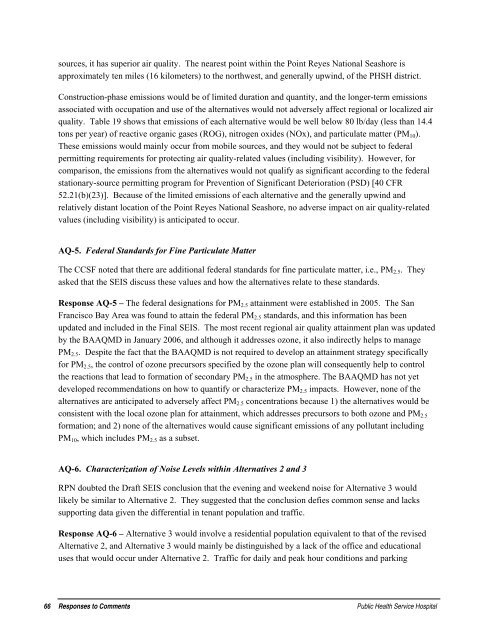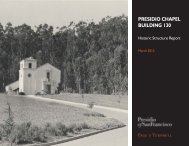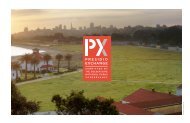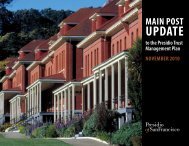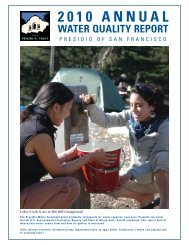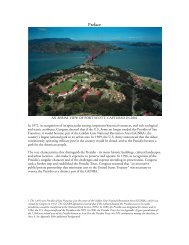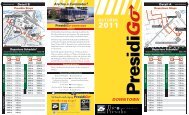Response to Comments - Presidio Trust
Response to Comments - Presidio Trust
Response to Comments - Presidio Trust
You also want an ePaper? Increase the reach of your titles
YUMPU automatically turns print PDFs into web optimized ePapers that Google loves.
sources, it has superior air quality. The nearest point within the Point Reyes National Seashore isapproximately ten miles (16 kilometers) <strong>to</strong> the northwest, and generally upwind, of the PHSH district.Construction-phase emissions would be of limited duration and quantity, and the longer-term emissionsassociated with occupation and use of the alternatives would not adversely affect regional or localized airquality. Table 19 shows that emissions of each alternative would be well below 80 lb/day (less than 14.4<strong>to</strong>ns per year) of reactive organic gases (ROG), nitrogen oxides (NOx), and particulate matter (PM 10 ).These emissions would mainly occur from mobile sources, and they would not be subject <strong>to</strong> federalpermitting requirements for protecting air quality-related values (including visibility). However, forcomparison, the emissions from the alternatives would not qualify as significant according <strong>to</strong> the federalstationary-source permitting program for Prevention of Significant Deterioration (PSD) [40 CFR52.21(b)(23)]. Because of the limited emissions of each alternative and the generally upwind andrelatively distant location of the Point Reyes National Seashore, no adverse impact on air quality-relatedvalues (including visibility) is anticipated <strong>to</strong> occur.AQ-5. Federal Standards for Fine Particulate MatterThe CCSF noted that there are additional federal standards for fine particulate matter, i.e., PM 2.5 . Theyasked that the SEIS discuss these values and how the alternatives relate <strong>to</strong> these standards.<strong>Response</strong> AQ-5 – The federal designations for PM 2.5 attainment were established in 2005. The SanFrancisco Bay Area was found <strong>to</strong> attain the federal PM 2.5 standards, and this information has beenupdated and included in the Final SEIS. The most recent regional air quality attainment plan was updatedby the BAAQMD in January 2006, and although it addresses ozone, it also indirectly helps <strong>to</strong> managePM 2.5 . Despite the fact that the BAAQMD is not required <strong>to</strong> develop an attainment strategy specificallyfor PM 2.5 , the control of ozone precursors specified by the ozone plan will consequently help <strong>to</strong> controlthe reactions that lead <strong>to</strong> formation of secondary PM 2.5 in the atmosphere. The BAAQMD has not yetdeveloped recommendations on how <strong>to</strong> quantify or characterize PM 2.5 impacts. However, none of thealternatives are anticipated <strong>to</strong> adversely affect PM 2.5 concentrations because 1) the alternatives would beconsistent with the local ozone plan for attainment, which addresses precursors <strong>to</strong> both ozone and PM 2.5formation; and 2) none of the alternatives would cause significant emissions of any pollutant includingPM 10 , which includes PM 2.5 as a subset.AQ-6. Characterization of Noise Levels within Alternatives 2 and 3RPN doubted the Draft SEIS conclusion that the evening and weekend noise for Alternative 3 wouldlikely be similar <strong>to</strong> Alternative 2. They suggested that the conclusion defies common sense and lackssupporting data given the differential in tenant population and traffic.<strong>Response</strong> AQ-6 – Alternative 3 would involve a residential population equivalent <strong>to</strong> that of the revisedAlternative 2, and Alternative 3 would mainly be distinguished by a lack of the office and educationaluses that would occur under Alternative 2. Traffic for daily and peak hour conditions and parking66 <strong>Response</strong>s <strong>to</strong> <strong>Comments</strong> Public Health Service Hospital


